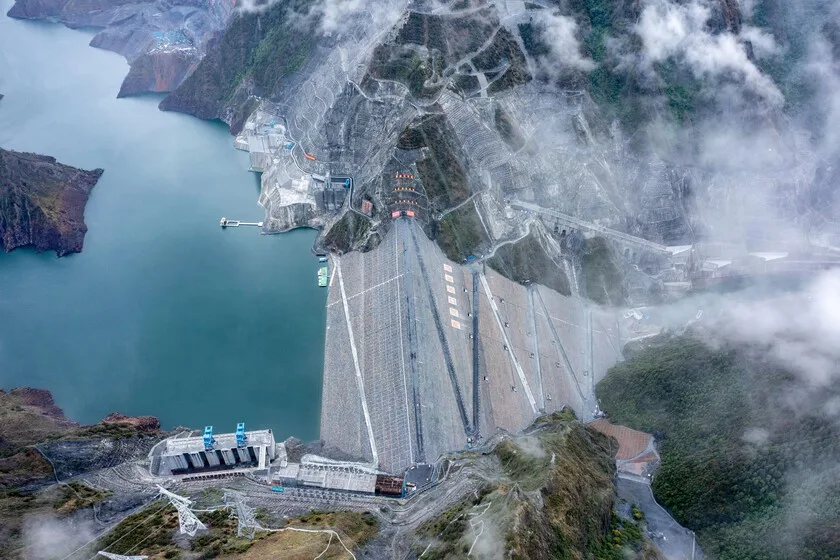beijingwalker
ELITE MEMBER

- Joined
- Nov 4, 2011
- Messages
- 65,191
- Reaction score
- -55
- Country
- Location
China recently commissioned the world’s largest hydro-photovoltaic
10/07/2023
ByNation World News Desk

Most countries around the world have set environmental targets to reduce emissions and achieve carbon neutrality over the next few years, but China is leading the race, and so far. It is on track to double its capacity and produce 1,200 gigawatts of wind and solar power by 2025 – more than the rest of the world combined – reaching the 2030 target it set five years ago.
Now, with a booming economy, it is undertaking dozens of massive infrastructure projects. One of them is the world’s largest combined solar and hydroelectric power plant.
Largest in the world. this plant The hydro-photovoltaic is located in the Yalong River Basin of Garze Tibetan Autonomous Prefecture in Sichuan Province. The plant covers an area of more than 16 square kilometers and includes more than 2 million solar panels. It has an installed capacity of 1 GW and will have a production capacity of 2 GW per year, which, to give you an idea, is equivalent to the energy consumption of over 700,000 homes for a year. It can fully charge 15,000 electric vehicles in just one hour.
https://nationworldnews.com/americas-failure-with-the-ukraine-project/
This means it saves over 600,000 tonnes of standard coal per year, reducing carbon dioxide emissions by over 1.6 million tonnes.
Target, The Banana plant is just one part of a huge renewable project that will produce clean energy for 100 million homes along the Yalong River, roughly equal to the population of the US. And for this, in this case, it has been decided to combine solar power with hydroelectricity: a way to balance the fluctuations of solar power, which generate more electricity during the day and less at night and clouds. Generates more electricity on sunny days than on cloudy days.
It will also make it possible to generate energy for a longer period, as solar power will be used in the dry season and hydroelectricity in the rainy season. Ultimately the goal is to avoid the waste inherent in relying on weather.
a complex construction. This plant is Titanic from the point of view of civil engineering. A total of 527,000 photovoltaic foundation piles have been installed and around 50,000 tonnes of steel have been used for its construction. One of the constraints was that it is located on a mountain 4,600 meters above sea level and 1,000 meters above the world’s highest city, Lhasa, which also makes it the highest-altitude project of its kind on the planet. Because of this, the builders faced extreme conditions and freezing cold, allowing only half of the year to work.
https://nationworldnews.com/russia-sets-cease-fire-for-evacuations-but-battles-continue/
Leaning, The project becomes a key element towards China’s goal of becoming emissions neutral by 2060, which could be achieved ahead of schedule if Asian countries continue on this path. As we at Xataka have commented in several articles, the country has followed a long-standing trend of ambitiously expanding its solar and wind power projects across its borders to achieve more stringent climate objectives than Western countries (given its huge energy consumption).
The trend has been accelerated by a series of energy policies implemented by his government in recent years, including subsidies to encourage developers as well as regulations to pressure provincial governments and companies.
https://nationworldnews.com/trouble-losing-weight-this-is-the-food-that-can-make-you-gain-weight/
compared to the rest of the world, Note that China’s utility-scale solar capacity has already reached 228 GW, which is more than the rest of the world combined. And it has also made great strides in wind capacity: its combined onshore and offshore capacity is now more than 310 GW, more than double the 2017 level and equal to the next top 7 countries combined. With new projects in Inner Mongolia, Xinjiang, Gansu and along the coast, China is on track to add another 371 GW by 2025, more than double what it already has.

China recently commissioned the world’s largest hydro-photovoltaic
Most countries around the world have set environmental targets to reduce emissions and achieve carbon neutrality over the next few years, but China is leading the race, and so far. It is on track to double its capacity and produce 1,200 gigawatts of wind and solar power by 2025 – more than the...
 nationworldnews.com
nationworldnews.com

